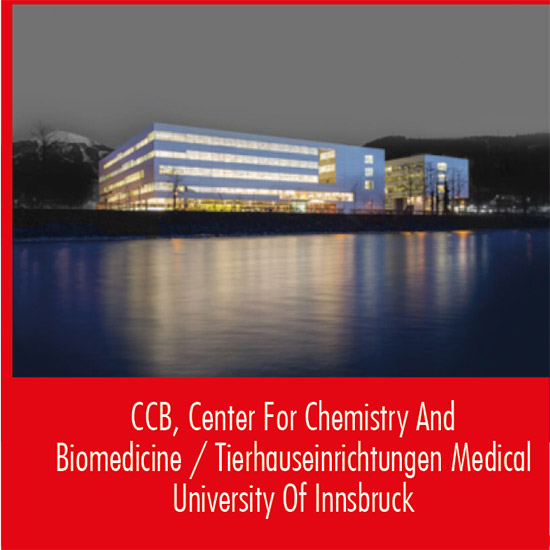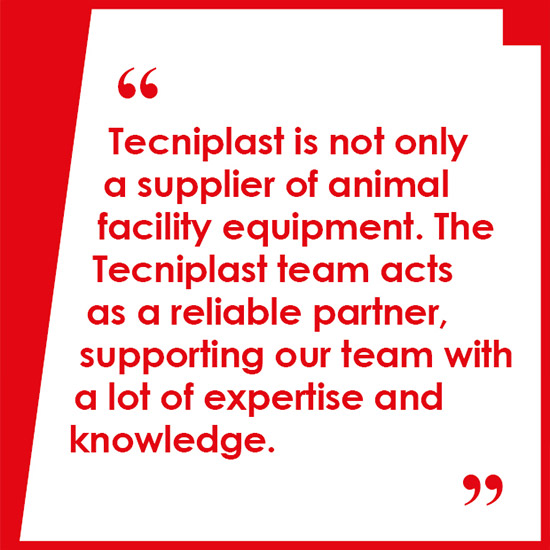
The current version of the Tecniplast website doesn't match your region. Please visit your local website to find information and offerings specific to your country.

The current version of the Tecniplast website doesn't match your region. Please visit your local website to find information and offerings specific to your country.

It’s not unusual to see robotics in Vivariums today: many facilities are already using automation to improve efficiency and flows, as well as to increase occupational health, and even more are planning to install robots in the future. Cage handling is a repetitive activity with many nuances, and the use of robotics in these tasks significantly reduces the exposure of staff to allergens, as well as occupational diseases, to the benefit of operators’ welfare.

Panorama meets Dr. Anja Beierfuß, Director of the animal facilities and designated veterinarian, as well as the elected chairwoman of the animal welfare body at the Medical University of Innsbruck.
The CCB research building is one of the biggest and modern animal facilities in Austria, which went into operation 10 years ago approximately. “We implemented our barrier unit with the CCB animal facility, which enabled us to house our unique and immunocompromised GA mouse colonies under controlled hygienic conditions” explains Dr. Beierfuß “Over the past 10 years, the barrier unit developed into our core breeding unit of GA mouse strains, currently housing approximately 6.000 mice. In our CCB animal facility, we have a team of 8 animal technicians and 2 technicians responsible for cage washing and equipment supply. Scientists have no physical access to the barrier unit, and they depend on animal technicians for all animal-related tasks in the unit”.
Coming to the cage cleaning process, 5.000 IVC cages to be cleaned weekly is quite a task, meaning a big requirement of human resources. Fortunately, more than 10 years ago it was decided to use automation in the washing area. Because of the limited space, the APOLLO, which processes integral GM500 cages, was the choice.
What were the main reasons behind the investment in such an automated cage-cleaning system?
The main reason for the investment was occupational health. We have numerous academic staff at our university, suffering from laboratory rodent allergies and we aimed to reduce the exposure time of animal facility staff to allergens.
Are your expectations fulfilled?
We have been able to improve operator protection and reduce the time that must be spent with high allergen concentrations. The capability of the automated system is not sufficient to take care of all cages that must be cleaned weekly. Manual processing is still necessary for our facility.
Would you recommend colleagues from other facilities to invest in automation?
In our facility, we hit the occupational health-related goal. Facilities with a similar focus could benefit from the robotic assistant. The reason why I like to name the system “robotic colleague”, or “robotic assistant”, is that technical defects may lead to sick leave. During that time there is the need to empty cages by hand, leading to unexpected work loading increase for animal facility staff.
Do the operators find the software user-friendly?
The operating system is simple and provides a good overview. There is a general design and structure of the operating systems used on all Tecniplast devices, that is self-explaining and operator friendly.
Based on your experiences, would you prefer to work with many different suppliers considering the complexity and required integration in your very big animal facility, or to cooperate with only one integrated solution provider?
There are pros and cons on both sides, but I would prefer to work with one provider, as this will ensure smoother integration and will reduce constant service costs.

What is your general opinion about Tecniplast as one of your major partners to keep your “benchmark facility” successfully working?
Tecniplast is not only a supplier of animal facility equipment. The Tecniplast team acts as a reliable partner, supporting our team with a lot of expertise and knowledge. I appreciate that, as a leading company on the market, Tecniplast always tries to support animal facilities as well as scientists to design customized solutions for small projects and budgets, which is quite important in academia.
In some of our older facilities, Tecniplast IVC systems run 24/7 for almost 20 years, now. So, I would like to honor the technical staff, that helps us to keep the systems going over such a long period. Even if they have a tight schedule, they always try to fix all technical problems they come across and provide some technical insight to our staff. Over the years, an excellent working partnership has been developing and our team is always excited to announce the regular service site visit.
GABY DORNER
AREA SALES MANAGER TECNIPLAST DEUTSCHLAND GMBH